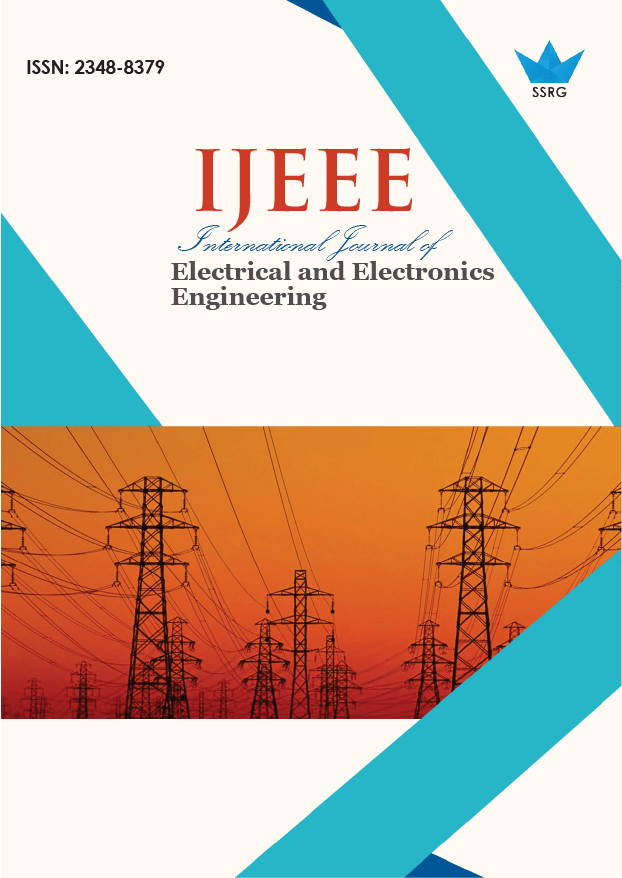Machine Learning-Based Severity of Critical Line for Power System Security Enhancement with Zip Loads

| International Journal of Electrical and Electronics Engineering |
| © 2025 by SSRG - IJEEE Journal |
| Volume 12 Issue 8 |
| Year of Publication : 2025 |
| Authors : S. Jayakumar, Venkatesh Peruthambi, Sudha Dukkipati, Pushpalatha kumari M, K. Manikandan |
How to Cite?
S. Jayakumar, Venkatesh Peruthambi, Sudha Dukkipati, Pushpalatha kumari M, K. Manikandan, "Machine Learning-Based Severity of Critical Line for Power System Security Enhancement with Zip Loads," SSRG International Journal of Electrical and Electronics Engineering, vol. 12, no. 8, pp. 29-37, 2025. Crossref, https://doi.org/10.14445/23488379/IJEEE-V12I8P104
Abstract:
This research proposes an advanced, data-driven framework to enhance power system security and operational reliability in the face of unforeseen faults and contingencies. A composite polynomial load model incorporating constant impedance (Z), constant current (I), and constant power (P) characteristics is employed to capture realistic load behavior under varying conditions. The methodology begins with modeling based on standard IEEE test systems, integrating this load model into power flow analysis using the Newton-Raphson algorithm. For contingency assessment, the focus is placed on single-line outage scenarios-critical events that may significantly impact system stability. A novel Hybrid Line Stability Ranking Index (HLSRI) is introduced to prioritise vulnerability, offering a more accurate ranking of transmission line criticality under stress conditions. Additionally, machine learning algorithms, including Gradient Boosting and Random Forest classifiers, are trained on system operational data to categorize the severity of line contingencies with high precision. To enhance control and stability, Flexible AC Transmission System (FACTS) devices such as the Unified Power Flow Controller (UPFC) and Interline Power Flow Controller (IPFC) are strategically deployed. Their optimal placements are determined through the metaheuristic Sparrow Search Algorithm (SSA), ensuring minimal power losses and improved dynamic performance. Simulation results validate the superiority of the proposed framework in terms of accuracy, adaptability, and system-wide resilience, making it a promising solution for real-time power grid reliability enhancement.
Keywords:
Contingency analysis, Gradient Boosting (GB), Hybrid Line Stability Ranking Index (HLSRI), Power system security, Polynomial load model, Random Forest (RF).
References:
[1] Reynato Andal Gamboa, Chockalingam Aravind Vaithilingam, and Chew Ai Chin, “Power System Network Contingency Studies,” 2018 IEEE Student Conference on Research and Development (SCOReD), Selangor, Malaysia, pp. 1-6, 2018.
[CrossRef] [Google Scholar] [Publisher Link]
[2] Jothy Venkateswaran et al., “Contingency Analysis of an IEEE 30 Bus System,” 2018 3rd IEEE International Conference on Recent Trends in Electronics, Information & Communication Technology (RTEICT), Bangalore, India, pp. 328-333, 2018.
[CrossRef] [Google Scholar] [Publisher Link]
[3] Anmar Arif et al., “Load Modeling - A Review,” IEEE Transactions on Smart Grid, vol. 9, no. 6, pp. 5986-5999, 2018.
[CrossRef] [Google Scholar] [Publisher Link]
[4] Partha P. Biswas et al., “Optimal Placement and Sizing of FACTS Devices for Optimal Power Flow in a Wind Power Integrated Electrical Network,” Neural Computing and Applications, vol. 33, no. 12, pp. 6753-6774, 2021.
[CrossRef] [Google Scholar] [Publisher Link]
[5] Ahmed Nasser Alsammak, and Hasan Adnan Mohammed, “A Literature Review on the Unified Power Flow Controller UPFC,” International Journal of Computer Applications, vol. 182, no. 12. pp. 23-29, 2018.
[CrossRef] [Google Scholar] [Publisher Link]
[6] Parimal Acharjee, “Optimal Power Flow with UPFC using Security Constrained Self-Adaptive Differential Evolutionary Algorithm for Restructured Power System,” International Journal of Electrical Power & Energy Systems, vol. 76, pp. 69-81, 2016.
[CrossRef] [Google Scholar] [Publisher Link]
[7] Sankalp Asawa, and Sam Al-Attiyah, “Impact of FACTS Device in Electrical Power System,” 2016 International Conference on Electrical, Electronics, and Optimization Techniques (ICEEOT), Chennai, India, pp. 2488-2495, 2016.
[CrossRef] [Google Scholar] [Publisher Link]
[8] Ayman Alhejji et al., “Optimal Power Flow Solution with an Embedded Center-Node Unified Power Flow Controller Using an Adaptive Grasshopper Optimization Algorithm,” IEEE Access, vol. 8, pp. 119020-119037, 2020.
[CrossRef] [Google Scholar] [Publisher Link]
[9] Sai Ram Seshapalli, “Analysis of Hybrid Power Flow Controller using Static Load Model under Contingency Screening,” 2019 IEEE International Conference on Clean Energy and Energy Efficient Electronics Circuit for Sustainable Development (INCCES), Krishnankoil, India, pp. 1-6, 2019.
[CrossRef] [Google Scholar] [Publisher Link]
[10] Akanksha Mishra, and G.V. Nagesh Kumar, “A Risk of Severity Based Scheme for Optimal Placement of Interline Power Flow Controller Using Composite Index,” International Journal of Power and Energy Conversion, vol. 8, no. 3, pp. 257-275, 2017.
[CrossRef] [Google Scholar] [Publisher Link]
[11] Siavash Yari, and Hamid Khoshkhoo, “Assessment of Line Stability Indices in Detection of Voltage Stability Status,” 2017 IEEE International Conference on Environment and Electrical Engineering and 2017 IEEE Industrial and Commercial Power Systems Europe (EEEIC / I&CPS Europe), Milan, Italy, pp. 1-5, 2017.
[CrossRef] [Google Scholar] [Publisher Link]
[12] Abdelfattah A. Eladl, Mohamed I. Basha, and Azza A. ElDesouky, “Multi-Objective-Based Reactive Power Planning and Voltage Stability Enhancement Using FACTS and Capacitor Banks,” Electrical Engineering, vol. 104, no. 5, pp. 3173-3196, 2022.
[CrossRef] [Google Scholar] [Publisher Link]
[13] Aditya Chorghade, and Vandana A. Kulkarni Deodhar, “FACTS Devices for Reactive Power Compensation and Power Flow Control - Recent Trends,” 2020 International Conference on Industry 4.0 Technology (I4Tech), Pune, India, pp. 217-221, 2020.
[CrossRef] [Google Scholar] [Publisher Link]
[14] N.S. Goutham, and Mohd. Z.A. Ansari, “Determination of Optimal Location of FACTS Devices for Power System Restoration Including Load Flow and Contingency Analysis,” International Journal of Engineering Research and Technology (IJERT), vol. 5, no. 18, pp. 1-4, 2017.
[Google Scholar] [Publisher Link]
[15] Krishnan Suresh, and Ezhilvannan Parimalasundar, “Design and Implementation of Universal Converter Design and Implementation of a Universal Converter,” IEEE Canadian Journal of Electrical and Computer Engineering, vol. 45, no. 3, pp. 272-278, 2022.
[CrossRef] [Google Scholar] [Publisher Link]
[16] Parimalasundar Ezhilvannan, and Suresh Krishnan, “An Efficient Asymmetric Direct Current (DC) Source Configured Switched Capacitor Multi-Level Inverter,” European Journal of Automated Systems, vol. 53, no. 6, pp. 853-859, 2020.
[CrossRef] [Google Scholar] [Publisher Link]
[17] Biplab Bhattacharyya, and Saurav Raj, “Swarm Intelligence Based Algorithms for Reactive Power Planning with Flexible AC Transmission System Devices,” International Journal of Electrical Power & Energy Systems, vol. 78, pp. 158-164, 2016.[CrossRef] [Google Scholar] [Publisher Link]

 10.14445/23488379/IJEEE-V12I8P104
10.14445/23488379/IJEEE-V12I8P104